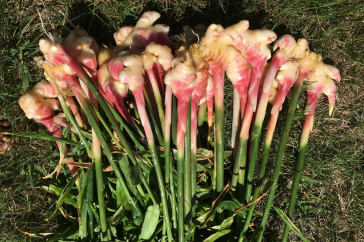The University of New Hampshire is a flagship research university that inspires innovation and transforms lives in our state, nation and world. More than 16,000 students from all 50 states and 71 countries engage with an award-winning faculty in top ranked programs in business, engineering, law, health and human services, liberal arts and the sciences across more than 200 programs of study. UNH’s research portfolio includes partnerships with NASA, NOAA, NSF and NIH, receiving more than $100 million in competitive external funding every year to further explore and define the frontiers of land, sea and space.
UNH Research Finds Early-Season Heating Shows Promise Boosting Ginger Harvest

There is growing regional interest in growing baby ginger. It can be used for cooking and can be candied or pickled. It also keeps well in the freezer for culinary use year-round. Credit: Becky Sideman/UNH
DURHAM, N.H. – For the relatively new crop known as “baby ginger,” delaying the harvest date increases yields in New Hampshire, according to preliminary research from the New Hampshire Agricultural Experiment Station at the University of New Hampshire.
“U.S. consumers are likely most familiar with the golden cured rhizomes of mature ginger plants, but recently, growers in the northeastern U.S. have been successfully producing ‘baby ginger,’ grown for just a single growing season. Unlike mature ginger, the baby ginger is pink, tender, non-fibrous, and perishable. It can be used for cooking and can be candied or pickled, and keeps well in the freezer for culinary use year-round,” said Sideman, experiment station research Becky Sideman, professor of plant biology and extension professor and specialist in sustainable horticulture production.
Given the regional interest in growing baby ginger, Sideman and Sabrina Beck, an undergraduate research assistant, wanted to explore if early-season heating dramatically increased end-of-season yields, if growing in a low tunnel rather than a high tunnel could decrease costs, and if yields and/or quality of ginger is reduced by harvesting early, rather than late in the fall.
In this one-year study, they found ginger rhizomes sprouted much faster in flats that were on heat mats than in flats that were not. In addition, the early season heating also resulted in higher ginger yields once the ginger was transplanted in high and low tunnels. At each harvest date, the plots with plants exposed to early season heating produced higher yields. With all dates combined, yields were significantly higher for the heated treatments.
“However, it is important to weigh this against the cost of heating. In our system, we ran a heat mat for nearly 12 weeks. We found that the first sprouts did not emerge until nearly six weeks after planting, even on the heat mat. Thus, the same results could likely be obtained by sprouting the ginger in a warm, insulated location without need for light for several weeks,” Sideman said.
When transplanted in high and low tunnels, the ginger in the high tunnels produced much higher yields than ginger grown in the low tunnels. According to Sideman, it is possible that low tunnels might be suitable for ginger production if other variables were modified, such as different coverings used and different fertility regime. However, based on these preliminary results, the high tunnel environment produced the best yields of high-quality ginger.
Finally, harvesting ginger early reduced yields. While it was possible to harvest nice ginger around Sept. 1, yields were doubled by waiting an additional two months. “The take-home message here is that growers should delay harvest to maximize yields, and only harvest what is needed for earlier markets. It also may be worth considering charging a premium price for ‘early’ baby ginger, as it will result in less yield overall,” Sideman said.
This material is based upon work supported by the NH Agricultural Experiment Station, through joint funding of the National Institute of Food and Agriculture, U.S. Department of Agriculture, under award number 1006928, and the state of New Hampshire. It also was supported by the NH Vegetable & Berry Growers’ Association. Additional information on this research is available from UNH Cooperative Extension in Effects of Early Season Heating, Low Tunnels and Harvest Time Ginger Yields in NH, 2017.
Founded in 1887, the NH Agricultural Experiment Station at the UNH College of Life Sciences and Agriculture is UNH’s original research center and an elemental component of New Hampshire's land-grant university heritage and mission.
PHOTOS AVAILABLE FOR DOWNLOAD
https://colsa.unh.edu/nhaes/sites/default/files/media/images/unhginger3.jpg
https://colsa.unh.edu/nhaes/sites/default/files/media/images/unhginger4.jpg
There is growing regional interest in growing baby ginger. It can be used for cooking and can be candied or pickled. It also keeps well in the freezer for culinary use year-round. Credit: Becky Sideman/UNH.
https://colsa.unh.edu/nhaes/sites/default/files/media/images/unhginger.jpg
https://colsa.unh.edu/nhaes/sites/default/files/media/images/unhginger5.jpg
Experiment station researchers found ginger rhizomes sprouted much faster in flats that were on heat mats than in flats that were not kept on heat mats. Credit: Becky Sideman/UNH.
https://colsa.unh.edu/nhaes/sites/default/files/media/images/unhginger2.jpg
https://colsa.unh.edu/nhaes/sites/default/files/media/images/unhginger6.jpg
When transplanted in high and low tunnels, the ginger in the high tunnels produced much higher yields than ginger grown in the low tunnels. Credit: Becky Sideman/UNH.
-
Media Contact
Lori Tyler Gula, PhD | NH Agricultural Experiment Station | lori.gula@unh.edu | 603-862-1452
Latest News
-
November 6, 2025
-
November 5, 2025
-
October 24, 2025
-
October 8, 2025
-
October 2, 2025
















































